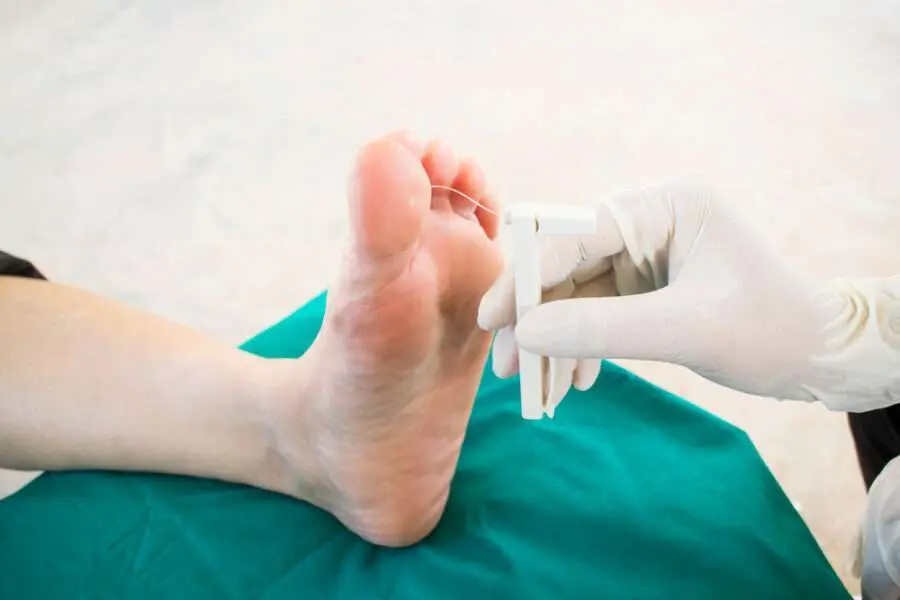
Diabetic foot is a problematic condition that can cause sores and ulcers. This makes the feet more vulnerable, especially among the elderly. If this condition is not treated promptly and effectively, it can lead to serious infections and, in some cases, amputation.
If you are one of the 880,000 Quebecers who are diabetic, you need to be especially vigilant about your feet. It is estimated that nearly 25% of diabetics will have foot sores during their lifetime. It is important to consult without delay if the sores are slow to heal. This is usually a sign that something is wrong.
Let’s take a look at what causes this condition, its symptoms and how the podiatrist can treat it.
Symptoms of diabetic foot
Whether you have type 1 or type 2 diabetes, you are at greater risk of developing a foot sore than the rest of the population. And because diabetes often causes problems with blood circulation and tissue rigidity, the sores become difficult to heal.
The consequences can be serious:
● Significant decrease in foot sensitivity
● Tingling and pain in the feet
● Leg pain
● Pressure points on the feet
● Increase in dryness of the feet
● Foot deformation (like hallux valgus bunions or hammer toe, claw toe, mallet toe)
Such foot symptoms are often insidious and it is very difficult to assess their severity on your own. The loss of sensation in the feet makes it more difficult for the diabetic person to judge the severity of their aches and pains. And waiting too long can lead to complications!
This is why the slightest wound, blister, crack or callus should be taken seriously by a diabetic person.
Secondary effects of diabetic foot
One of the main side effects of diabetic foot is neuropathy. This is a pathology that affects the nerves of the feet. In people with diabetes, too much glucose in the blood damages the nerves, especially those of the legs and feet.
In addition to hyperglycemia, neuropathy is also caused by high blood pressure, excess weight or smoking.
Cardiovascular problems caused by diabetes are also involved. In fact, diabetics are at least twice as likely to suffer from cardiovascular disease.
The diabetic foot can therefore be the consequence of arteriopathy, which is a pathological disease of the arteries. One of the most common forms of arteriopathy in diabetics is atherosclerosis. Diabetes accelerates the deterioration of the arteries, which often leads to atherosclerosis. This is a hardening of the arteries due to an accumulation of fat.
Preventing diabetic foot
Obviously, this foot pathology is first and foremost prevented by controlling an adequate blood sugar level. In this way, you prevent the problem at the source.
However, there are other precautions that can be taken to avoid complications:
● Wash and inspect your feet daily.
● Consult a podiatrist at least once a year.
● Choose comfortable and flexible shoes.
● Avoid high heels or shoes that are too narrow.
● Avoid walking barefoot.
● Trim your toenails frequently (and don’t cut them too short).
● Keep your feet dry.
● Change your socks frequently.
● Wear white socks.
Treating diabetic foot
Diabetic foot treatment should be carried out by a podiatrist, who will be able to conduct a thorough examination of your lower limbs and determine the most appropriate treatment for your particular condition.
Your podiatrist will evaluate the neurological and vascular condition of your foot. They can also suggest specific shoes and prescribe foot orthotics to prevent this pathology.
In particular, your podiatrist can treat :
● Corns, calluses and severe corns caused by diabetes
● Lesions
● Ulcers
● Pressure points of the foot
In extreme cases of damage, amputation of the foot will be necessary. However, this remains a last resort.
It is important to always keep in mind that the best treatment to prevent these complications is to properly manage blood sugar levels.
PiedRéseau, an alliance of podiatrists across Quebec, working to prevent diabetic foot complications
PiedRéseau brings together nearly forty clinics across Quebec to treat all foot pathologies. Their podiatrists use the latest technology and design treatments adapted to your needs. This enables them to accurately assess your condition.
If you have diabetes, see a trusted podiatrist on a regular basis. They will be able to quickly determine if you require any treatment.
Contact PiedRéseau to protect your feet from the complications of diabetes.